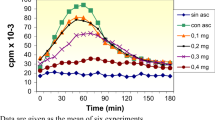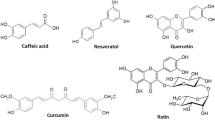Abstract
N-(p-Coumaroyl)serotonin (C) and N-feruroylserotonin (F) with antioxidative activity are present in safflower oil. The protective effects of C and F were investigated in perfused guinea-pig Langendorff hearts subjected to ischemia and reperfusion. Changes in cellular levels of high phosphorous energy, NO and Ca2+ in the heart together with simultaneous recordings of left ventricular developed pressure (LVDP) were monitored by an nitric oxide (NO) electrode, fluorometry and 31P-NMR. The rate of recovery of LVDP from ischemia by reperfusion was 30.8% in the control, while in the presence of C or F a gradual increase to 63.2 or 61.0% was observed. Changes of transient NO signals (TNO) released from heart tissue in one contraction (LVDP) were observed to be upside-down with respect to transient fura-2-Ca2+ signals (TCa) and transient O2 signals detected with a pO2 electrode. At the final stage of ischemia, the intracellular concentration of Ca2+ ([Ca2+]i) and the release of NO increased with no twitching and remained at a high steady level. The addition of C increased the NO level at the end of ischemia compared with the control, but [Ca2+]i during ischemia decreased. On reperfusion, the increased diastolic level of TCa and TNO returned rapidly to the control level with the recovery of LVDP. By in vitro EPR, C and F were found to directly quench the activity of active radicals. Therefore, it is concluded that the antioxidant effects of two derivatives isolated from safflower play an important role in ischemia-reperfusion hearts in close relation with NO.
Similar content being viewed by others
References
Goldharber JL, Weiss JN: Oxygen free radicals and cardiac reperfusion abnormalities. Hypertension 20: 118–127, 1992
Dhalla NS, Wang X, Beamish RE: Intracellular calcium handling in normal and failing hearts. Exp Clin Cardiol 1: 7–20, 1996
Ferrari R: The role of mitochondria in ischemic heart disease. J Cardiovasc Pharmacol 28(suppl 1): S1–S10, 1996
Griendling KK, Alexander RW: Oxidative stress and cardiovascular disease. Circulation 96: 3264–3265, 1997
Kaplan P, Lehotsky J, Racay P: Role of sarcoplasmic reticulum in the contractile dysfunction during myocardial ischemia and reperfusion. Physiol Res 46: 333–339, 1997
Hotta Y, Fujita M, Nakagawa J, Ando H, Takeya K, Sakakibara J: Contribution of cytosolic ionic and energetic milieu change to ischemia-and reperfused-induced injury in guinea-pig heart: Fluorometry and nuclear magnetic resonance studies. J Cardiovasc Pharmacol 31: 146–156, 1998
Hotta Y, Otsuka-Murakami H, Fujita M, Nakagawa J, Yajima M, Ishikawa N, Kawai N, Masumizu T, Kohno M: Protective role of nitric oxide synthase in myocardial mitochondria against ischemia-reperfusion injury in guinea pigs. Eur J Pharmacol 380: 37–48, 1999
Hotta Y, Nakagawa J, Wakida Y, Ishikawa N, Ando H, Takeya K, Ohashi N, Matsui K: Protective effect of SM-20550, a selective Na+-H+ exchange inhibitor, on ischemia-reperfusion injured hearts. J Cardiovasc Pharmacol 37: 143–154, 2001
Hotta Y, Ishikawa N, Ohashi N, Matsui K: Effects of SM-20550, a selective Na+-H+ exchange inhibitor, on the ion transport of myocardial mitochondria. Moll Cell Biochem 219: 83–90, 2001
Dhalla NS, Elmoselhi AB, Hata T, Makino N: Status of myocardial antioxidants in ischemia-reperfusion injury. Cardiovasc Res 47: 446–56, 2000
Kaneko M, Matsumoto Y, Hayashi H, Kobayashi A, Yamazaki N: Oxygen free radicals and calcium homeostasis in the heart. Mol Cell Biochem 139: 91–100, 1994
Ide T, Tsutsui H, Kinugawa S, Utsumi H, Kang D, Hattori N, Uchida K, Arimura K, Egashira K, Takesita A: Mitochondrial electron transport complex I is a potential source of oxygen free radicals in the failing myocardium. Circ Res 85: 357–363, 1999
Cao Y, Hotta Y, Shioi K, Nagata Y, Kawai N, Ishikawa N: Protective effects of FK409, a novel NO-donor, against post-ischemic myocardial dysfunction in guinea-pig hearts. J Cardiovasc Pharmacol 38: 593–605, 2001
Nagatsu A, Tenmaru K, Matsuura H, Murakami N, Kobayashi T, Okuyama H, Sakakibara J: Novel antioxidants from roasted perilla seed. Chem Pharm Bull 43: 887–889, 1995
Zhang HL, Nagatsu A, Watanabe T, Sakakibara J, Okuyama H: Antioxidative compounds isolated from Safflower (Carthamus tinctorius L.) Oil Cake. Chem Pharm Bull 45: 1910–1914, 1997
Hotta Y, Ando H, Takeya K, Sakakibara J: Direct measurement of increased myocardial cellular 23Na NMR signals in perfused guinea-pig heart induced by dihydroouabain and grayanotoxin-I. Mol cell Biochem 139: 59–70, 1994
Koike A, Abe T, Hotta Y, Takeya K, Kodama I, Toyama J: Protective effects of dimethyl amiloride, a potent Na+-H+ exchange inhibitor, against post-ischemic myocardial dysfunction: 31P-NMR measurements of pHi and cellular energy in isolated perfused rabbit hearts. J Thorac Cardiovasc Surg 112: 765–775, 1996
Hotta Y, Ando H, Fujita M, Nakagawa J, Takeya K, Sakakibara J: Different effects of isoproterenol and dihydroouabain on cardiac Ca2+ transients. Eur J Pharmacol 282: 121–130, 1995
Ozaki H, Satoh T, Karaki H, Ishida Y: Regulation of metabolism and contraction by cytoplasmic calcium in the intestinal smooth muscle. J Biol Chem 264: 14074–14079, 1988
Ichimori K, Ishida H, Fukabori M, Nakazawa H, Murakami E: Practical nitric oxide measurement employing a nitric oxide-sensitive electrode. Rev Sci Instrum 65: 1–5, 1994
Higuchi H, Satoh T: Endothelin-1 induces vasoconstriction and nitric oxide release via endothelin ETB receptors in isolated perfused rat liver. Eur J Pharmacol 328: 175–182, 1997
Liu W, Kato M, Akhand AA, Hayakawa A, Suzuki H, Miyata T, Kurokawa K, Hotta Y, Ishikawa N. Nakashima I: 4-hydrooxynonenatal independent redox-related activation of caspase-3. J Cell Sci 113: 635–641, 2000
Ogawa N, Tanaka K, Asanuma M, Kawai M, Masumizu T, Kohno M, Mori A: Bromocriptine protects mice against 6-hydroxydopamine and scavenges hydroxyl free radicals in vitro. Brain Res 657: 207–213, 1994
Xu KY, Huso DL, Dawson TM, Bredt DS, Becker LC: Nitric oxide synthase in cardiac sarcoplasmic reticulum. Proc Natl Acad Sci USA 96: 657–662, 1999
Tamura M, Oshino N, Chance B, Silver LA: Optical measurements of intracellular oxygen concentration of rat heart in vitro. Arch Biochem Biophys 191: 8–22, 1978
Pinsky DJ, Patton S, Mesaros S, Brovkovych V, Kubaszewski E, Grunfeld S, Malinski T: Mechanical transduction of nitric oxide synthesis in the beating heart. Circ Res 81: 372–379, 1997
Smith JA, Shah AM, Lewis MJ: Factors released from endothelium of the ferret and pig modulates myocardial contraction. J Physiol 439: 1–14, 1991
Zweier JL: Measurement of superoxide-derived free radicals in the reperfused heart. Evidence for a free radical mechanism of reperfusion injury. J Biol Chem 263: 1353–1357, 1988
Wang PH, Zweier JL: Measurement of nitric oxide and peroxynitrite generation in the post-ischemic heart-evidence for peroxynitrite-mediated reperfusion injury. J Biol Chem 271: 29223–29230, 1996
Xia Y, Dawson VL, Dawson TM, Snyder SH, Zweier JL: Nitric oxide synthase generates superoxide and nitric oxide in arginine-depleted cells leading to peroxynitrite-mediated cellular injury. Proc Natl Acad Sci USA 93: 6770–6774, 1996
Mayer B, Hemmens B: Biosynthesis and action of nitric oxide in mammalian cells. Trends Biochem Sci 22: 477–481, 1997
Cosentino F, Patton S, d'Uscio LV, Werner ER, Werner-Felmayer G, Moreau P, Malinski T, Luscher TF: Tetrahydrobiopterin alters superoxide and nitric oxide release in prehypertensive rats. J Clin Invest 101: 1530–1537, 1998
Liu P, Hock CE, Nagele R, Wong PY-K: Formation of nitric oxide, superoxide, and peroxynitrite in myocardial ischemia-reperfusion injury in rats. Am J Physiol 272: H2327–H2336, 1997
Yasmin W, Strynadka KD, Schulz R: Generation of peroxynitrite contributes to ischemia-reperfusion injury in isolated rat hearts. Cardiovasc Res 33: 422–432, 1997
Ronson RS, Nakamura M, Vinten-Johansen: The cardiovascular effects and implications of peroxynitrite. Cardiovasc Res 44: 47–59, 1999
Mayer B, Schrammel A, Klatt P, Koesling D, Schmidt K: Peroxynitrite-induced accumulation of cyclic GMP in endothelial cells and stimulation of purified soluble guanylyl cyclase. Dependence on glutathione and possible role of S-nitrosation. J Biol Chem 270: 17355–17360, 1995
Altug S, Demirvurek AT, Cakici I, Kanzik I: The beneficial effects of peroxynitrite on ischemia-reperfusion arrhythmias in rat isolated hearts. Eur J Pharmacol 384: 157–62, 1999
Ronson RS, Thourani VH, Ma XL, Katzmark SL, Han D, Zhao ZQ, Nakamura M, Guyton RA, Vinten-Johansen J: Peroxynitrite, the breakdown product of nitric oxide, is beneficial in blood cardioplegia but injurious in crystalloid cardioplegia. Circulation 100: 384–391, 1999
Shah AM, MacCarthy PA: Paracrine and autocrine effects of nitric oxide on myocardial function. Pharmacol Ther 86: 49–86, 2000
Kawashima S, Hayashi M, Takii T, Kimura H, Zhang HL, Nagatsu A, Sakakibara J, Murata K, Oomoto Y, Onozaki K: Serotonin derivative, N-(p-Coumaroyl)serotonin, inhibits the production of TNF-α, IL-1α, IL-1β, and IL-6 by endotoxin-stimulated human blood monocytes. J Interf Cytok Res 18: 423–428, 1998
Takii T, Hayashi M, Hiroma H, Chiba T, Kawashima S, Zhang HL, Nagatsu A, Sakakibara J, Onozaki K: Serotonin derivative, N-(p-Coumaroyl)serotonin, isolated from Safflower (Carthamus tinctorius L.) Oil Cake augments the proliferation of normal human and mouse fibroblasts in synergy with basic fibroblast growth factor (bFGF) or epidermal growth factor (EGF). J Biochem 125: 910–915, 1999
Barnes NM, Sharp T: A review of central 5-HT receptors and their function. Neurophamacology 38: 1083–1152, 1999
Muto T, Cao Y, Hotta Y, Ishikawa N, Kato M, Okada K, Nagata M: Protective effects of sarpogrelate, a 5-HT2A antagonist, against postischemic myocardial dysfunction in guinea-pig hearts. Jpn J Pharmacol 85: 75P, 2001
Author information
Authors and Affiliations
Rights and permissions
About this article
Cite this article
Hotta, Y., Nagatsu, A., Liu, W. et al. Protective effects of antioxidative serotonin derivatives isolated from safflower against postischemic myocardial dysfunction. Mol Cell Biochem 238, 151–162 (2002). https://doi.org/10.1023/A:1019992124986
Issue Date:
DOI: https://doi.org/10.1023/A:1019992124986




